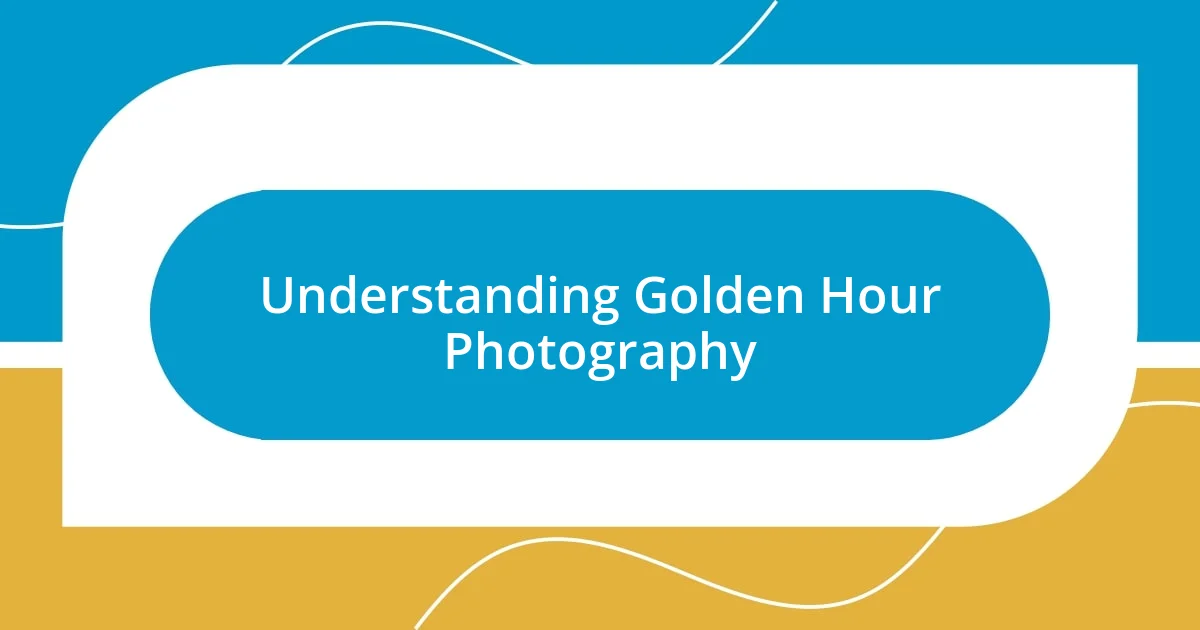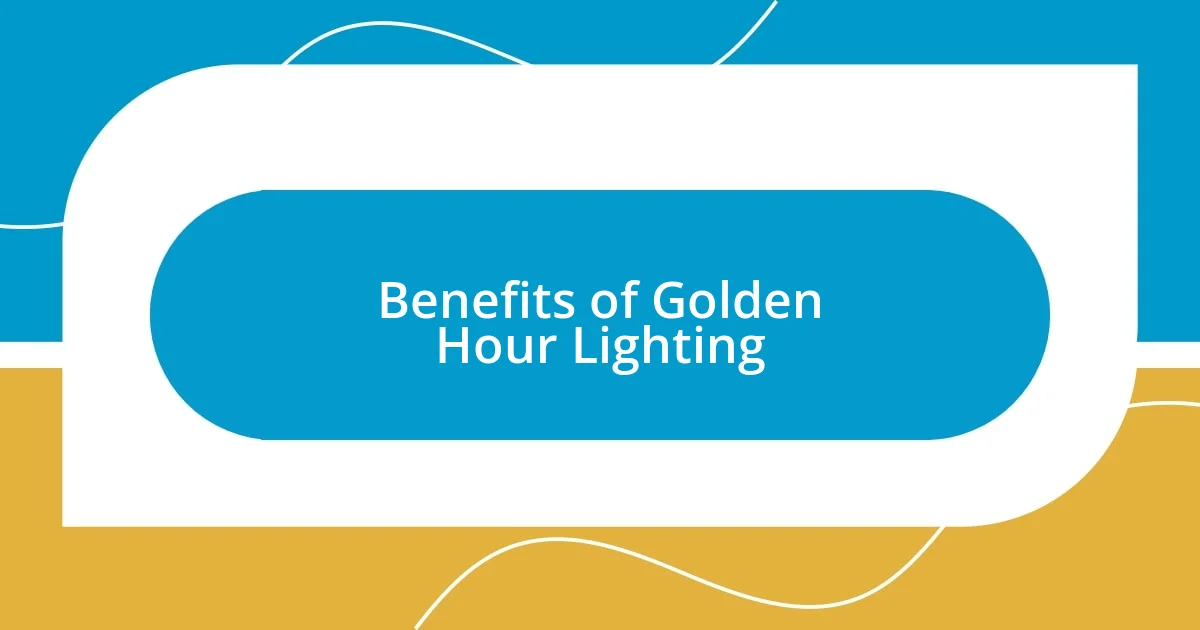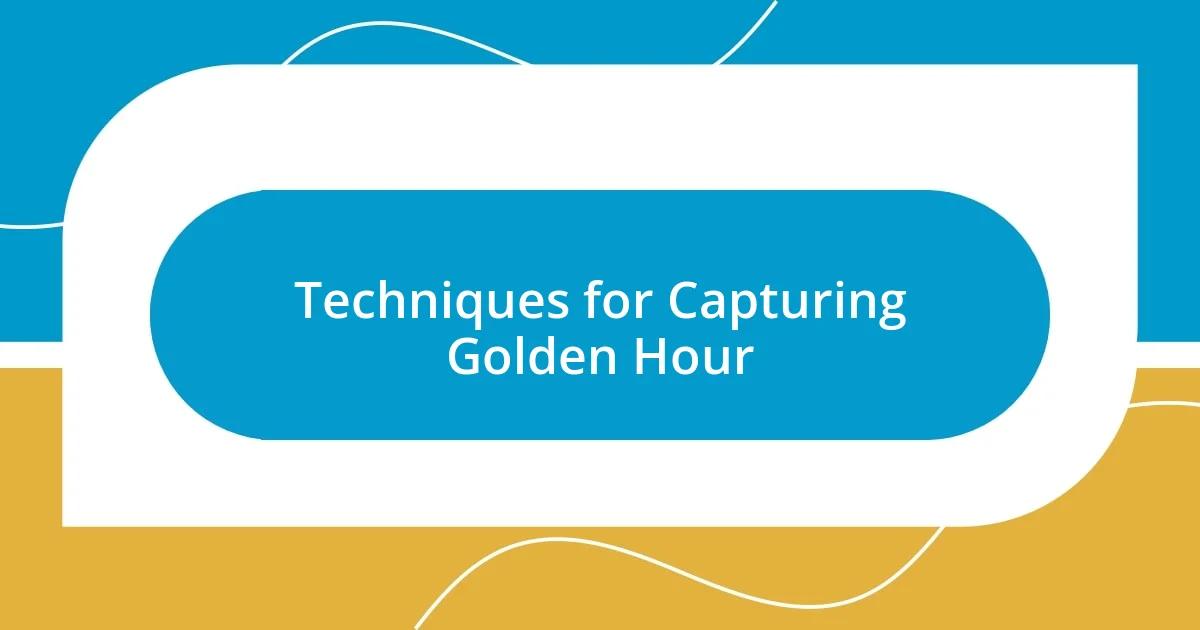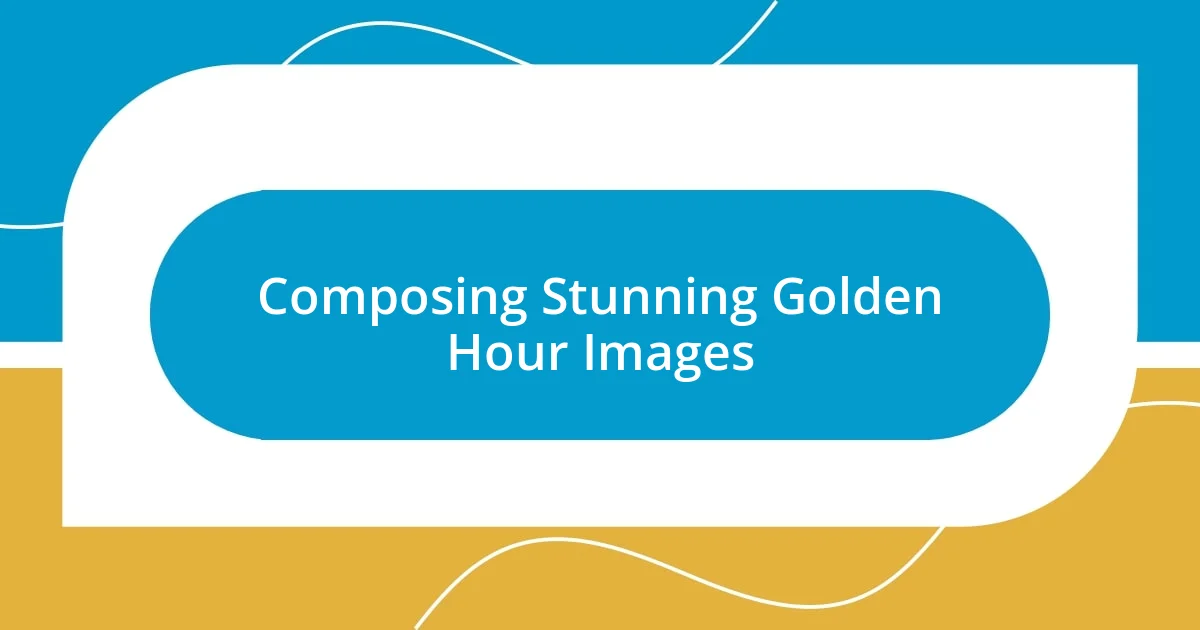Key takeaways:
- Golden hour photography captures soft, warm light that enhances emotional impact, creating stunning visuals with vibrant colors and minimized harsh shadows.
- Essential equipment for golden hour shoots includes a lightweight camera, a fast lens, a sturdy tripod, a polarizing filter, and extra batteries for continuity.
- Techniques for success involve timing, positioning subjects against the light for beautiful silhouettes, incorporating reflections for depth, and utilizing composition rules like the rule of thirds to create engaging images.

Understanding Golden Hour Photography
Golden hour photography, that magical time just after sunrise or before sunset, bathes the world in soft, warm light. I can still remember my first golden hour shot; the way the sun kissed the landscape felt like a painter’s gentle brushstrokes. Have you ever felt that rush when everything comes together perfectly, creating an image that’s almost otherworldly?
During this brief window, the sunlight creates long shadows and vibrant colors that can transform even the most mundane scenes into stunning compositions. I often find myself wandering through parks at this time, captivated by the way the light dances on leaves and rivers. Isn’t it amazing how a simple change in lighting can evoke such deep emotions and offer a different perspective on the world around us?
What I adore about golden hour is the unpredictability; each evening offers a unique palette of colors. Sometimes, I chase those fleeting moments, heart racing, hoping to capture something that reflects the beauty I see. It’s fascinating how this natural phenomenon invites not just a change in scenery but also an opportunity for introspection, don’t you think?

Benefits of Golden Hour Lighting
The beauty of golden hour lighting is that it offers a fantastic opportunity for creating mood. The soft, warm tones enhance the emotional impact of my images, often conveying a sense of serenity and nostalgia. I distinctly remember capturing a sunset over a lake, where the golden hues mirrored the reflection on the water. It was a moment where the image transcended mere photography; it became a story frozen in time.
One of the most significant benefits is that golden hour lighting minimizes harsh shadows. This gentle lighting wraps subjects in a flattering glow, which makes portraits feel softer and more inviting. During my last shoot, I saw how the light softened the facial features of my subjects, allowing their true expressions to shine through. Have you ever noticed how a little light can make a huge difference in how we perceive beauty?
Lastly, golden hour brings out colors in a way that feels almost magical. The reds and oranges in the sky, contrasted with the lush greens of nature, create a striking visual harmony. I vividly recall photographing a field of wildflowers during golden hour; the colors popped in a way that felt surreal. It’s this transformative power of light that keeps me coming back for more.
| Aspect | Benefit |
|---|---|
| Emotional Impact | Creates a warm, nostalgic atmosphere |
| Soft Shadows | Flattering for portraits and subjects |
| Vivid Colors | Enhances the richness of the scene |

Equipment for Golden Hour Shoots
When gearing up for a golden hour shoot, the right equipment can make all the difference. I often pack a lightweight camera that’s easy to handle, as the fleeting nature of this time means I need to be quick and agile. A sturdy tripod is also essential; I can’t tell you how many times setting up the perfect shot has relied on a stable base, especially when capturing the delicate play of light on water or trees.
Here’s a quick list of gear I recommend for those magical moments:
- Camera: A DSLR or mirrorless camera for better low-light performance.
- Lens: A fast lens (with a low f-stop) to blur backgrounds and capture beautiful bokeh.
- Tripod: A sturdy one to keep your shots steady, especially in low light.
- Polarizing Filter: This reduces glare and enhances colors, making skies pop.
- Extra Batteries: Golden hour may be brief, but the memories you capture shouldn’t be cut short by a dead battery.
Most importantly, I always keep a sense of openness with my gear. Sometimes, I capture stunning shots with my smartphone just because it’s there and ready in my pocket. It’s about being adaptable to the environment and the light’s mood. Last summer, I found myself snapping incredible sunset portraits at the beach, using nothing but my handheld device, and the results were breathtaking. That flexibility has only deepened my appreciation for this enchanting time of day.

Techniques for Capturing Golden Hour
To truly excel in golden hour photography, timing is everything. I always check the golden hour times in advance, as the window of opportunity is typically brief and varies by location. On one memorable evening, I arrived at a viewpoint just as the sun was dipping behind the mountains, and it felt exhilarating as I clicked away, knowing that I was capturing nature’s most spectacular show in real-time. Have you ever felt the thrill of chasing the perfect light?
Positioning your subjects is another vital technique. I often find that placing subjects against the light rather than facing it creates beautiful silhouettes that emphasize shape and form. During a recent portrait session with a friend, I positioned her backlit by the sun. The result was an ethereal glow that transformed the image, making it feel like a magical moment captured forever. Isn’t it fascinating how a simple change in angle can lead to such striking differences in mood?
Lastly, incorporating reflection can add depth and intrigue to your photos. Whether it’s a calm lake or a puddle after rain, I love to explore how reflections can enhance the golden hour’s ambiance. One evening, I found a small puddle by the path, and as I lowered my camera to capture the reflected colors of the sunset, I realized that I was not just photographing a scene—I was creating a layered story. What hidden perspectives can you find when you take a moment to really look around?

Composing Stunning Golden Hour Images
When composing stunning golden hour images, I’ve found that the rule of thirds can elevate a shot dramatically. By aligning the horizon along the lower third, I create more interest in the sky while still showcasing the beauty of the landscape below. One evening, I experimented with this principle as I watched clouds catch fire in brilliant hues—framing the shot this way not only emphasized the colors but also drew the viewer’s eye across the entire scene. Have you ever tried shifting your composition to see how it transforms the story in your photo?
Lighting plays an equally crucial role in composition during golden hour. The soft, diffused light creates a gentle glow that enhances details in both landscapes and portraits. I recall the time I was capturing a friend’s candid laughter; the light streaming through the trees illuminated her face perfectly, giving the shot an almost magical quality. How often do we underestimate the power of light in our images?
Additionally, leading lines can guide the viewer’s eye through the image, enriching the overall composition. I remember standing on a winding path as the sun dipped beneath the horizon; I used the path as a leading line to draw focus to a vibrant sunset. This technique not only added depth but also invited the viewer into the scene. What paths or shapes in your surroundings could serve as visual guides for your next golden hour shot?

Sharing Your Golden Hour Work
Sharing your golden hour work can be an incredibly fulfilling experience. Whenever I post my favorite shots, whether on social media or in a photography group, I always feel a thrill as I anticipate feedback from fellow enthusiasts. It’s like opening a window into my creative world; have you ever felt that blend of excitement and vulnerability when sharing something so personal?
Engagement with your audience can take many forms. Once, I shared a photo of a misty lake during golden hour, and it sparked a lively discussion about the gear used and the emotions evoked by the scene. This interaction reminded me that photography isn’t just about visuals—it’s about connection and storytelling. How does your audience engage with your work?
Lastly, consider curating your golden hour images into themed collections. I once created a small book featuring shots from various landscapes, each captured during those magical minutes before nightfall. As I flipped through the pages, I felt a wave of nostalgia wash over me—a reminder of every adventure and emotion tied to each shot. What stories do your golden hour photos tell?












